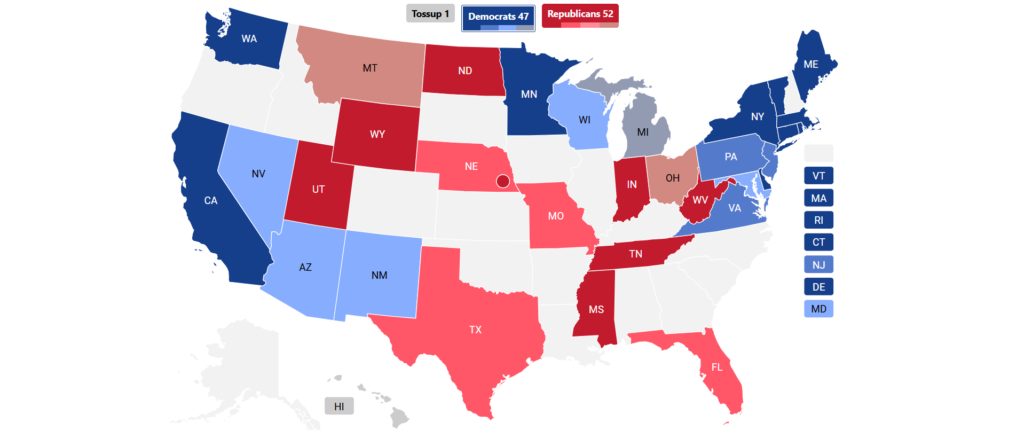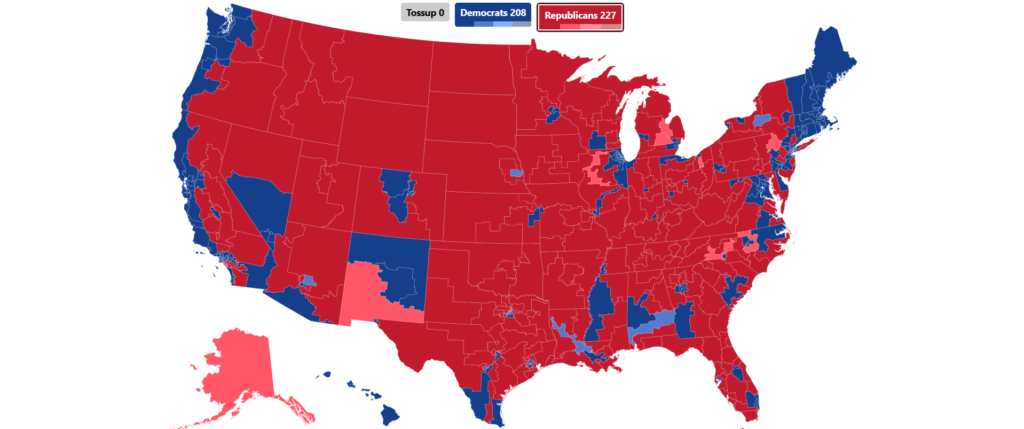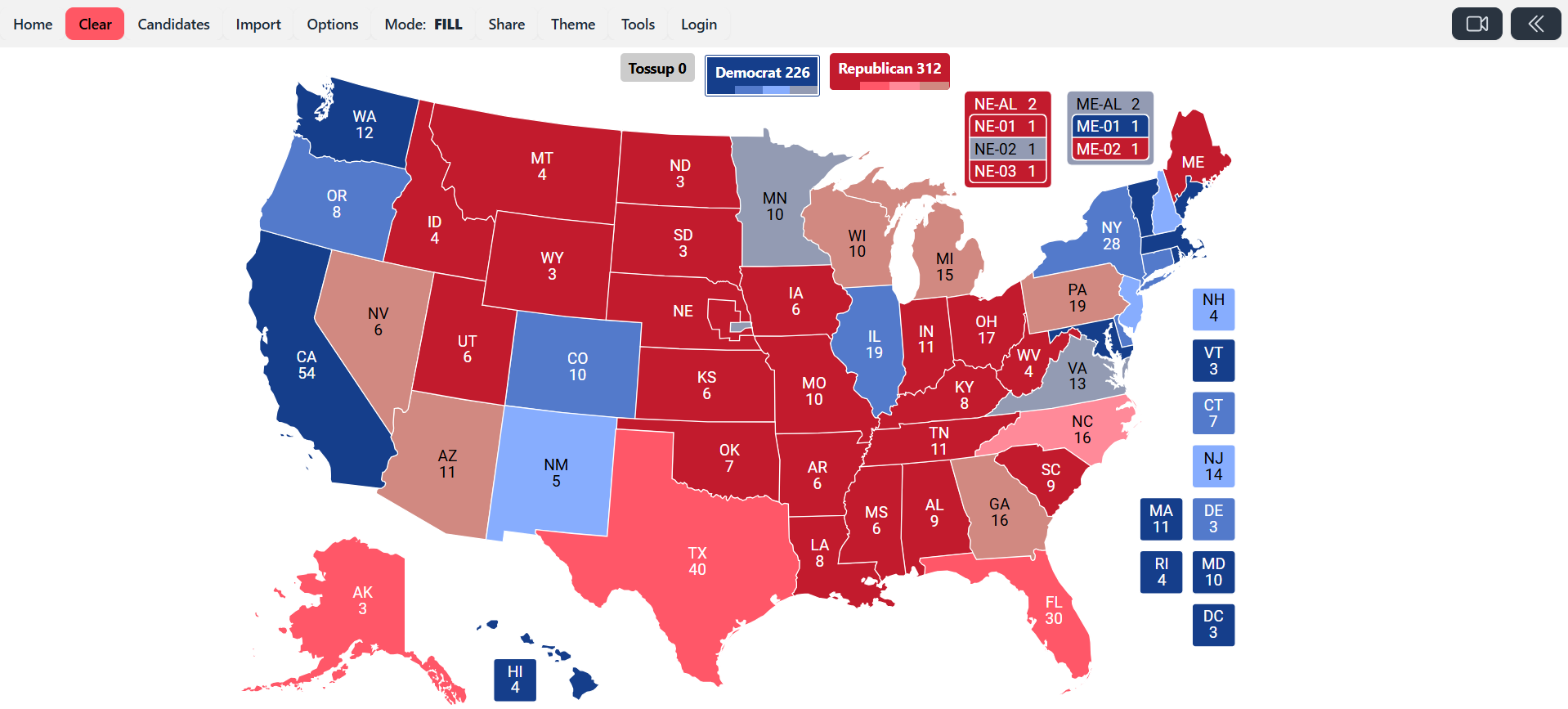The Messenger has been covering and forecasting the national elections since the summer. Our presidential forecast showed former President Donald Trump (R-FL) with 235 electoral votes and Vice President Kamala Harris (D-CA) with 225 votes. 270 are needed to win.
This week, we’re shifting a few states as the race has continued to develop.
Arizona (11): Toss Up to Tilts Republican: Trump has held thin but consistent leads in the polls here. While the aggregates show the race is within the margin of error, we think this is one that goes to him just based on the numbers. Joe Biden (D-DE) held a two-point lead in the averages in 2020 and won the state by a thin margin. While Democrats would likely enjoy keeping Arizona in their column, it’s not necessary for Harris’ path to victory. Republicans have surged ahead of 2020 early vote totals, making for another reason that a Trump win in Arizona seems likelier than not.
Connecticut (7): Safe Democrat to Likely Democrat: This is a cautious shift only because of possible swing in New York towards Trump. If economics is a key issue – and Trump regularly polls as the preferred candidate on handling this issue – then a wealthy state like Connecticut might deliver a thinner-than-usual margin for Harris. If anything, this shift indicates a “margin watch” on her part.
Delaware (3): Safe Democrat to Likely Democrat: The logic here is similar to Connecticut, but bounded more by economics. More than half of Fortune 500 companies are incorporated in Delaware because of its friendliness towards business. The state was not remotely in play in 2016, yet Delaware swung almost ten points to the right that year. An argument for Trump’s position in handling the economy might see Delaware swing back towards him, especially without native son Biden on the ticket. Like Connecticut, this is also a prohibitive shift to watch for a slip in Harris’ margin. Harris’ plan to greatly increase the tax on unrealized capital gains is not likely to go over well in this pro-business environment.
Georgia (16): Toss Up to Tilts Republican: Trump’s leads here have been just as consistent as they have been in Arizona, but some of the margins are wider. Fundamentally, Georgia is still a red-leaning state, and if Trump emerges with historic levels of black support, it would likely erase Democratic gains in the rapidly-expanding Atlanta areas. Like Arizona, Georgia is a trophy for Democrats, but not needed to hit 270. Biden’s average lead here was about one point in 2020; Trump has that lead doubled as of press time. A polling miss would likely see a slightly larger margin than that in his favor.
Illinois (19): Safe Democrat to Likely Democrat: Like Delaware and Connecticut, this is another “margin watch” state, simply because if Trump’s appeal in New York is as broad as we think, then it would likely transcend to a state with similar problems. Moreover, a significant shift in the Latino and black populations to Trump would likely push Illinois more towards the right than Democrats would prefer.
Maine (2): Leans Democrat to Tilts Democrat: Maine’s two at-large electoral votes were unusually in play in 2016, so much so that Maine was almost a sleeper upset for Trump. Biden swung it back in his corner in 2020, and what little polling we have shows Harris with decent, yet not insurmountable leads. We think that if enthusiasm for Trump is on 2016-levels, then Maine is absolutely within the margin of error. We’ll still give Harris a slight edge due to the fundamental lean of the state, but Republicans will very likely continue to play here for the coming cycles.
Michigan (15): Toss Up to Tilts Republican: Republicans have not polled as well as Trump has in Michigan in decades, and even though the aggregates find the race to be a complete coin toss, a race that tight is usually one Trump wins.
Nebraska CD-02 (1): Toss Up to Leans Democrat: This sole electoral vote is not a huge site of campaign visits, but in a close election, like 2020, it certainly can be. Neither campaign has been on the ground as much as they have been in 2020, but Harris has decent leads here. Trump would be wise to avoid spending resources for a sole vote he doesn’t necessarily need. As the Omaha area might drift to the left, it’s not likely to make or break this election.
Nevada (6): Toss Up to Tilts Republican: This is a tough call, mainly because polls in Nevada tend to vastly underestimate Democratic support over the last few cycles. But Trump’s polling among Latino voters, Republicans’ leads in early voting, and our own conversations on the ground in the Silver State make us think Trump has a slight edge in flipping this state red for the first time since 2004.
New Jersey (14): Likely Democrat to Leans Democrat: This call comes after conversations with people on the Trump campaign, who feel very confident about New Jersey. No Republican has won here since 1988, and our logic here is that if Trump led the polls here shortly before Biden’s exit in July, then Harris’ ceiling can’t be that much improved. Polling puts her around low-to-mid double-digits, which would be a somewhat underwhelming Democratic victory in this otherwise blue state. Trump’s appeal in New York is likely to have residual effects on New Jersey, as a good amount who attended his three Empire State rallies came from just next door. We wouldn’t be surprised to see New Jersey much closer this year than it is in other years.
Pennsylvania (19): Toss Up to Tilts Republican: This is the state that the entire election comes down to for either campaign. Like in Michigan, although it’s a statistically tied race, it’s one where Trump likely prevails. The GOP has opened an early voting lead and the ground game has been bigger here than perhaps in any other state. Republicans have registration advantages in historically blue counties, making us think there’s a good floor of support for the former president.
Virginia (13): Leans Democrat to Tilts Democrat: Like Maine, this is another sleeper target for Trump. Polling after the Biden exit had him leading in the state, and while Harris has had consistent leads, they’re not at the levels we saw in 2020. Trump is making a last-minute play for the state, but unless there’s a significant polling miss, Harris might narrowly walk away with Virginia.
Wisconsin (10): Like the other two Rust Belt states, a statistically tied race is probably one Trump can win. Of those three Midwestern giants, Wisconsin is the state where polls whiffed the worst in both 2016 and 2020. Wisconsin was also much closer than neighboring Michigan in 2020, making us think Trump can flip this state back into his column.
Our final forecast gives Trump a baseline of 312 electoral votes, six more than his 2016 win. This is a forecast, and in the event of a polling miss in either candidate’s favor, it could be a different end result.
If Trump overperforms, he’s likely taking Minnesota, New Mexico, Maine, Virginia, and possibly New Hampshire and NE-02, for an Electoral College win of 347. Anything north of that seems highly unlikely, but if the campaign’s confidence in New Jersey is warranted, then that would likely be a 361 win for Trump.
If Harris overperforms, she’s likely holding the entire Biden coalition (307 votes) and flipping North Carolina. Her last-minute pull of $2 million worth of ads on the state’s media markets likely signals she’s surrendering this state this cycle.
A realistic best-case scenario for Trump is our forecast: 312 electoral votes. He could repeat his 306 total in 2016 if he were to lose Nevada and win everything else.
A realistic best-case scenario for Harris is 276 or 287, with the difference being Arizona’s 11 votes. We think Georgia is just out of reach for her this cycle, but if she can preserve the status quo, with Arizona being give-or-take, she would narrowly win in the College.
U.S. Senate
In the Senate, Republicans have the home-field advantage with a map that features practically no seats that Democrats could realistically contest to pad their likely losses. The GOP is highly likely to flip West Virginia and we retain Montana with a “Tilts Republican” rating. Polls show Tim Sheehy (R) steadily ahead of Senator Jon Tester (D). We were thinking of pushing this to a “Leans GOP” rating, but a recording of Sheehy making somewhat apathetic remarks about abortion makes us think this intrinsically libertarian state with an abortion measure on the ballot this year might not go as hard for Sheehy as some observers believe.
Arizona: Tilts Democrat to Leans Democrat: Congressman Ruben Gallego (D, AZ-03) is holding thick and consistent leads against former news anchor and 2022 gubernatorial candidate Kari Lake (R). Even as we think Trump will win the state, voters here seem set on splitting their tickets.
Michigan: Toss Up to Tilts Democrat: As Senate Democrats have run ahead of Harris in the battleground states, Michigan is one that will probably see Congresswoman Elissa Slotkin (D, MI-07) take this open seat. Mike Rogers (R) could flip this in an upset, but it would depend on Trump’s margin of victory in the state. Although we think Trump will carry Michigan, his margin will likely not be much greater than razor-thin, effectively erasing Rogers’ margin for error.
Nebraska: Safe Republican to Likely Republican: Senator Deb Fischer (R) has a relatively quiet profile in the Senate which is being challenged by Independent Dan Osborn, a Navy Veteran, steamfitter, and former labor union leader. Polling shows Osborn pulling within the margin of error, but many of the polls are sponsored by him. We’re shifting this out of observation of a likely margin slip for Fischer, in addition to the fact that no Democrat is running in this race. Vote-splitting will not be a factor here, likely aiding Osborn’s candidacy. Nebraska is intensely Republican, so we think Fischer will get by, but if Osborn wins, it remains to be seen which party he would caucus with should he earn a six-year term in Washington.
Nevada: Toss Up to Leans Democrat: This race has really gotten away from Sam Brown (R). Although Jacky Rosen (D) hasn’t been the most vocal Senator, our talks with people on the ground in the Silver State make us believe there’s a ticket-splitting aspect in play here, similar to that in Arizona. Polling is also not on Brown’s side, and in a state where Republicans are usually overestimated in the polls, it might mean he’s even more underwater than the polls estimate. It would take a big miss to see him win this seat. It’s possible, but we’re inclined to believe Rosen is a slight favorite for a second term.
Ohio: Toss Up to Tilts Republican (Flip): Senator Sherrod Brown (D-OH) is in the fight of his life to retain his Senate seat in a once-quintessential swing state that has raced to the right in the Trump era. We think that Trump is on track to take Ohio by about 12-13 points, which makes for a brutal task in crossover appeal not usually seen in the modern era. Bernie Moreno (R) has caught up to Brown in the polls, marking a stark contrast from the last time Brown ran in 2018. We think the GOP flips this seat.
At this point, we’re comfortable with our forecast of 52 seats for the GOP in the Senate. Three flips in West Virginia, Montana, and Ohio seem more likely than not at this point, with the possibility of GOP upsets in Michigan, Wisconsin, and Pennsylvania. We’ll even add New Mexico to that list as an abundance of caution. Democratic targets don’t seem to be panning out, with the GOP holding leads in Florida and Texas. This Senate map hasn’t really expanded like how it did in 2018. On both presidential and senatorial levels, we think Florida votes to the right of Texas.
U.S. House
Republicans have a tenuous 221-seat majority in the lower chamber. In a contest with few underdogs, we believe Republicans have the advantage in retaining their majority and possibly expanding it.
Republican Flips
AK-AL: Alaska’s at-large district is a tough one to call, mainly because of Mary Peltola’s (D) incumbency advantage. But polls have shown Nick Begich III (R) catching her in a rematch, and without another Republican candidate spoiling the ballot, we think this is a narrow GOP flip. On the other hand, we wouldn’t be surprised to see Peltola hang on.
CA-47: Scott Baugh (R) ran against Katie Porter (D) here and narrowly lost in 2022. Now, he’s back for the open seat. Polls have been tight, but with consistent Baugh leads.
IL-17: This carefully-gerrymandered district takes in Rockford, the Iowa suburbs of Moline and Rock Island, and heads down to Peoria and Bloomington. The old version of the district is one that Trump carried. We think his working-class message will appeal in this part of the state, creating an environment where Eric Sorensen (D, IL-17) narrowly misses a second term. However, this is a race that could go either way.
MI-07: This Lansing-based district was narrowly defended three times by Elissa Slotkin, who is vacating the seat to run for Senate. Tom Barrett (R) was 2022’s nominee, and the half-rematch, open-seat dynamic in a state poised to flip to Trump makes us think he flips this seat.
MI-08: The areas of Saginaw, Flint, Midland, and Bay City were key to Trump’s 2016 upset here, and these cities, once solidly Democratic, have raced to the right in the last eight years. The seat is open, making us believe the time is ripe as ever for the GOP to flip this seat.
NM-02: The sprawling Second District of New Mexico was gerrymandered to be more Democratic-leaning. Yvette Herrell (R) flipped this seat in 2020, but lost it in 2022. She’s running a rematch against incumbent Gabe Vasquez (D). While polling gives Vasquez the edge, we think there’s a shift among Latino voters that would give way to a Herrell win in NM-02.
NC-06: Republicans drew a gerrymander so hard, Democrats chose not to contest this seat.
NC-13: Carefully drawn around the outskirts of Raleigh-Durham, Wiley Nickel (D) chose not to seek re-election. GOP is favored to flip.
NC-14: Another gerrymander, this time around Charlotte, that saw one-term Jeff Jackson (D) quit the race early.
OH-13: The areas of Akron and North Canton were one the bread and butter of Democrats’ Ohio machine. Now, much of that area is Trump country. We think the GOP picks off this northeastern Ohio district.
PA-08: Matt Cartwright (D) has defied odds before, both with Trump on and off the ballot. But the machine that the GOP has assembled in Pennsylvania might be too much for Cartwright to overcome in this Scranton-Wilkes Barre-based district. Republicans also now lead in registration in Luzerne County, a historically working-class Democratic county.

Democratic Flips
AL-02: Redistricting mandated a second black-majority district in Alabama. Polls show a surprisingly tight race, but one that Democrats are likely to pick up.
AZ-01: The sprawling Phoenix suburbs look likely to swallow Dave Schweikert (R) this year, as he only narrowly survived in 2022. If Trump’s coattails are large enough, it could insulate him from defeat, but we think there’s a lot of ticket-splitting happening here and we don’t assume Schweikert is on the good end of it.
NE-02: Don Bacon (R) has survived tough election after tough election, but usually when the polling is more even-handed. This time, Tony Vargas (D) has led almost every survey, and that, coupled with Harris’ apparent strength in the Omaha-based district, makes us think Bacon is already underwater.
NY-22: Brandon Williams (R) is a freshman Congressman filling the shoes of a well-known maverick who survived the 2018 midterms. Democrats’ mid-decade redistricting shuffle made this Syracuse-based seat slightly bluer, which makes us think, in this polarizing time, that Williams might not make it out of this one. He could certainly win, but fundamentals make us assume otherwise.
LA-06: Redistricting mandated a second black-majority district in Louisiana. Democrats are a heavy favorite to flip this seat.

Upset Alert
These seats are on what we call “Upset Alert,” in that we could easily be surprised by how far the pendulum can swing in House races, especially when they depend almost entirely on presidential coattails. We think both parties win these seats as they appear, but we contend that some are simply too close to call and others are likely to rely on other factors.
Republican Upset Alert Seats: AZ-06, CA-13, IA-03, MI-10, NY-04, NY-17, NY-19, OR-05
Democrat Upset Alert Seats: CA-09, CO-08, CT-05, FL-09, IN-01, ME-02, MD-06, NV-03, NY-18, NC-01, OH-09, OR-06, PA-07, TX-34, VA-07, WA-03
Gubernatorial Elections
Our final toss up on the gubernatorial map was New Hampshire, which we think will go to Kelly Ayotte (R) by a narrow margin. The race is essentially locked up for Josh Stein (D) in North Carolina, while we’re watching for upsets in Washington. Some close polls in Indiana warrant a “Likely R” rating, but the last-minute narrowing of the gap is unlikely to result in an Election Day upset.
A Final Note
These are simply predictions based on what we’re seeing and what information is readily available to us. We enjoy bringing this otherwise national content to our readers on the local level, and we look forward to doing the autopsy on the election, regardless of how accurate our forecast is or is not.




